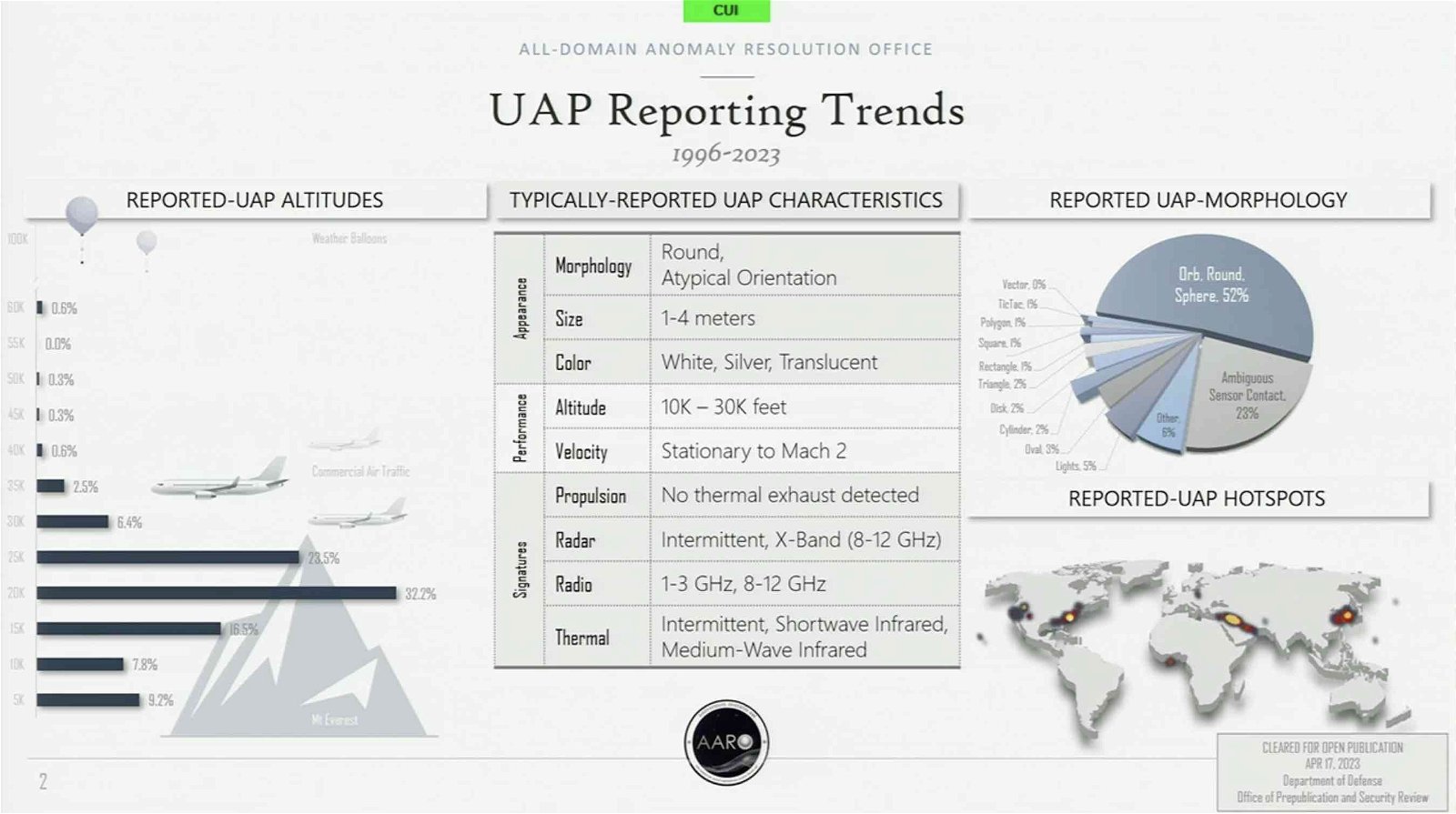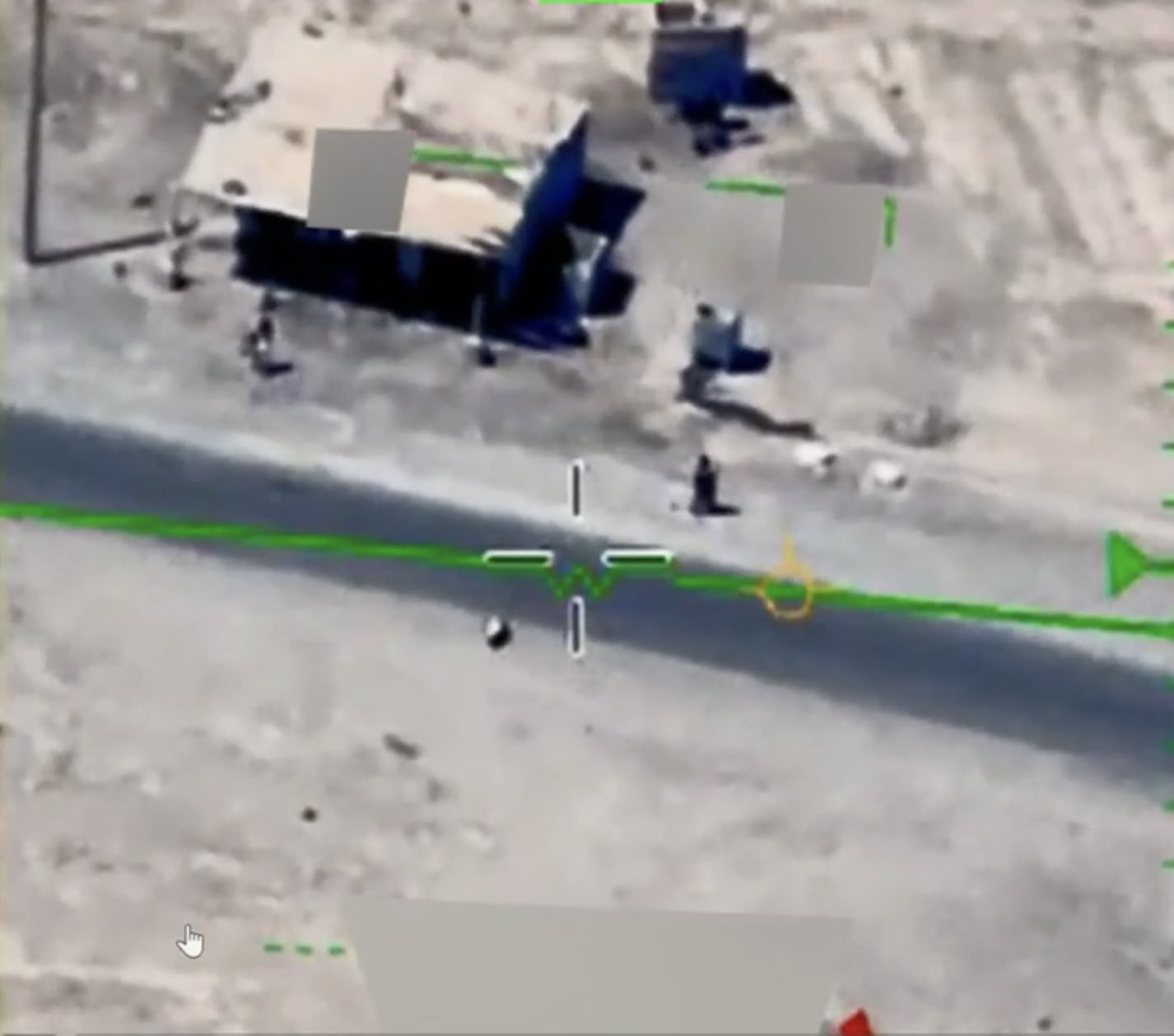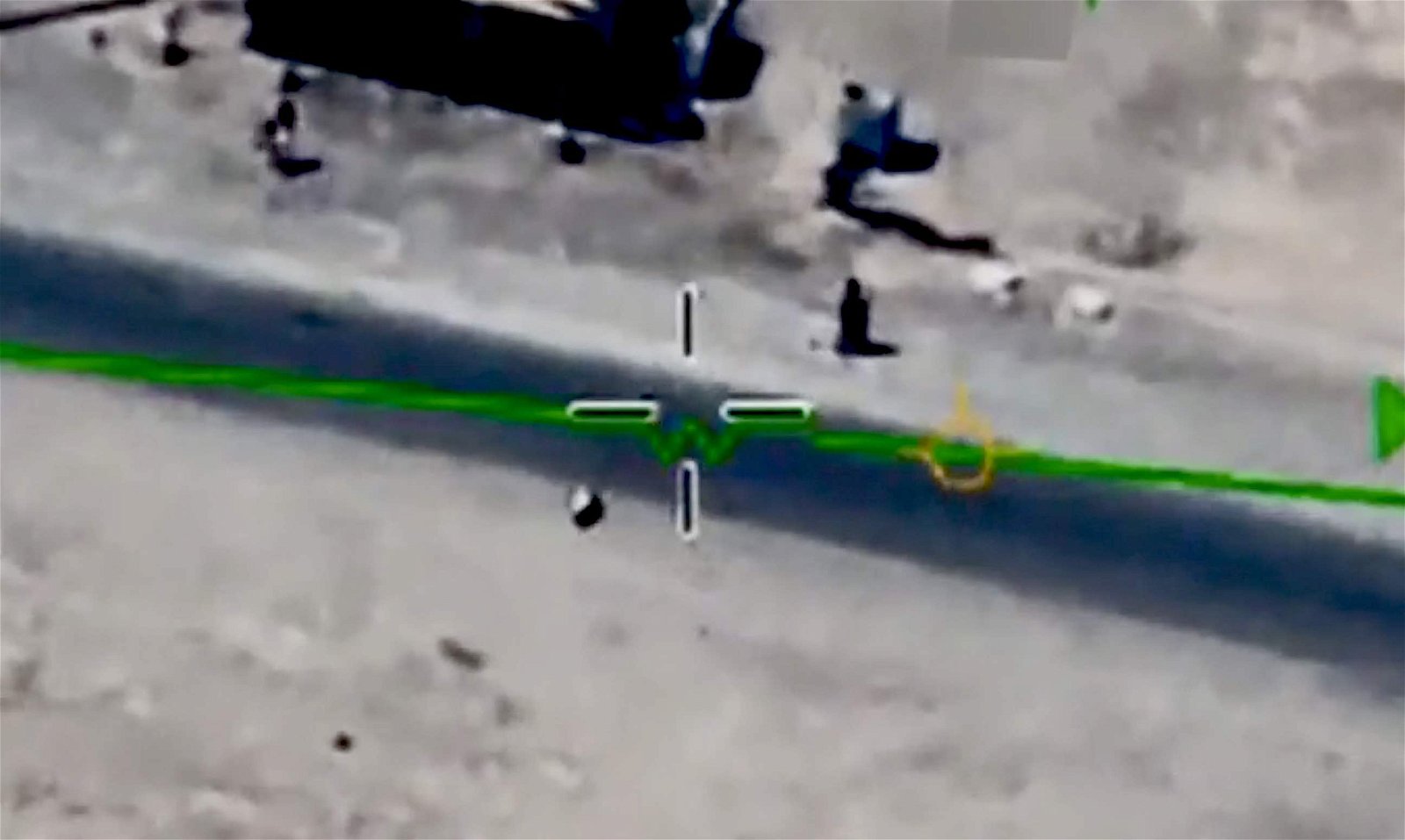Common shapes of unidentified anomalous phenomena (UAP), their flight dynamics and other reported characteristics, and a pair of new videos were among the new information presented on Wednesday at a hearing by the Senate Subcommittee on Emerging Threats and Capabilities, which focused on the Pentagon’s All-domain Anomaly Resolution Office (AARO).
During the open portion of the session led by U.S. Senator Kirsten Gillibrand (D-NY), questions were presented to Dr. Sean M. Kirkpatrick, the Director of AARO and the sole witness for Wednesday’s hearing, about its investigations into unidentified aerial objects encountered by U.S. personnel.
“We don’t know where they come from, who made them, or how they operate,” Gillibrand said in her opening remarks, referring to anomalous incursions that AARO is tasked with investigating. Gillibrand expressed additional concerns about the limited operational budget allocated to the Office, as well as coordination between AARO and other agencies regarding recent incidents involving unidentified aerial objects shot down over the U.S. and Canada earlier this year.
“We cannot keep turning a blind eye to surveillance data that is critical to detecting and tracking UAP,” Gillibrand added, before turning the session over to Dr. Kirkpatrick.
“AARO has accomplished much in the last nine months since it was established,” Kirkpatrick said in his opening statement, noting the Office has primarily focused on the four areas that include operations, scientific research, integrated analysis, and strategic communications.
“AARO is leading a focused effort to better characterize, understand, and attribute UAP,” Kirkpatrick said, adding that a complete historical review is being undertaken regarding information from past government efforts to collect information on the phenomenon.
“It would be naïve to believe that the resolution of all UAP can be solely accomplished by the DOD and IC alone,” Kirkpatrick emphasized, noting that partnerships with academia and the scientific community, as well as interagency partners and industry, will be required to analyze the challenging dataset that UAP represent.


Kirkpatrick also said that a minority of the reports AARO has collected appear to display anomalous flight or other performance characteristics. He added that humans are subject to a variety of stimuli and that misperceptions and lack of sufficient data could account for many claims involving seemingly anomalous UAP incidents.
“That is not to say that UAP, once resolved, are not of National Security interest,” Kirkpatrick said.
Kirkpatrick also was clear in emphasizing early on that none of the information his Office has collected is suggestive of extraterrestrial origins behind UAP, nor any technologies beyond our current scientific understanding.
“I should also state clearly for the record that in our research, AARO has found no credible evidence thus far of extraterrestrial activity, off-world technology, or objects that defy the known laws of physics,” Kirkpatrick said.
“I encourage those who hold alternative theories or views to submit your research to credible, peer-reviewed scientific journals. AARO is doing the same. That is how science works, not by blogs and social media,” Kirkpatrick added.
Common UAP Shapes, Flight Dynamics, and Other Characteristics
Following opening statements, Kirkpatrick shared a series of slides depicting information related to characteristics ascribed to various UAP reports AARO has collected.
Most UAP reports in the current AARO dataset were observed or detected within altitudes of around 15,000 to 20,000 feet, a range that Kirkpatrick said coincided with the abundance of air traffic.
In terms of shapes of the objects, Kirkpatrick said that around half of all UAP reported are round or generally spherical. Other shapes attributed to the objects include Oval (3%), Cylinder (2%), Disc (2%), Triangle (2%) Tic Tac (1%), Polygon (1%), Square (1%), and Rectangle (1%). Additionally, some objects are merely referred to as Lights (5%), which bore no distinctive shape.


Typically reported UAP characteristics included an appearance morphology described as “Round, Atypical Orientation,” ranging in size generally from 1-4 meters and most commonly white, silver, or translucent in coloration.
In terms of flight dynamics, UAPs have been observed hovering stationary and moving at speeds up to Mach 2, and the absence of any thermal exhaust or other propulsion is also commonly reported. Radar detection of the objects is “Intermittent, X-Band (8-12 GHz)”, with radio detections most often falling between 1-3 GHz and 8-12 GHz. Thermal detections of several objects comprised “Intermittent, Shortwave Infrared, [and] Medium-Wave Infrared.”
Kirkpatrick also cited a “heavy collection bias” that relates UAP “hotspots” with areas where the collection equipment used by USG agencies to collect that information.
Videos: New UAP Case Analysis
Following his opening statements, Kirkpatrick presented two examples of UAP footage his Office has collected and analyzed. These included what appears to be clear footage filmed by an MQ-9 Reaper drone, which captured a metallic spherical object passing below it with its electro-optical sensors as it moved over an undefined region of the Middle East.
Kirkpatrick said the footage of the object alone represents most of the information AARO currently has and that the case related to this video remains in the “active archive pending discovery of additional data.”


The second video, obtained in South Asia earlier this year, also involved an MQ-9 that observed a UAP object that, on initial viewing, appeared to display some variety of propulsion trail.
However, Kirkpatrick said the apparent wake left by the object in the footage obtained was in actuality “a sensor artifact” representing the object as it moves across the frame.
“We pulled these apart frame by frame,” Kirkpatrick said, noting that AARO was able to resolve that the object actually turns out to have merely been a conventional aircraft.
Kirkpatrick said he presented these two examples to illustrate the kinds of data his Office is working with presently, noting that the metallic sphere features in the first image “is an unresolved case we are still studying.”
Previously, The Debrief reached out to the Pentagon for comment on a similar piece of footage that was widely circulated online earlier this year, which was reportedly obtained over Mosul, Iraq, but did not receive a response to our queries.
Kirkpatrick said there are roughly 650 similar UAP cases his Office is currently working with and told members of the Committee that he has assembled a pair of teams–an intelligence community team, and a science and technology team comprised of engineers, physicists, and others–that are performing a competitive analysis of data AARO is collecting.
Kirkpatrick added that AARO’s next quarterly report is expected to be delivered this summer, with the next annual report following later this year.
China, Russia, and Foreign Threats
Senator Joni Ernst also asked Kirkpatrick whether it is “possible that the Chinese or Russian advanced technologies could be causing some of these anomalous behaviors,” to which Kirkpatrick expressed several concerns.
“China, in particular, are on par or ahead of us in some areas,” Kirkpatrick stated.
“The adversary is not waiting. They are advancing, and they are advancing quickly.”
Kirkpatrick added that U.S. foreign adversaries “are less risk-averse at technical advancement than we are. They are just willing to try things and see if it works.”
“Are there capabilities that could be employed against us in both in ISR and in a weapons fashion? Absolutely,” he said. Although he did not say evidence of this existed, Kirkpatrick nonetheless said there are “concerning indicators.”
“There are some authorities that we need,” Kirkpatrick said, noting good relationships AARO has with various IC components, but added that additional abilities for collection, tasking, counterintelligence, and other areas would be helpful. Kirkpatrick confirmed to Gillibrand that his Office would be willing to outline such requested abilities for inclusion with the language submitted by the Senate for the National Defense Authorization Act for the forthcoming fiscal year.
Whistleblowers On the Record and the Future of AARO
During Wednesday’s hearing, Gillibrand also addressed the so-called “whistleblower” provision outlined in the FY 2023 NDAA, requesting information about the establishment of a publicly accessible online portal that can be used for the collection of witnesses that can be interviewed by AARO. Kirkpatrick confirmed that several such individuals had been interviewed by his team, several of which were forwarded to his Office by members of the Senate.
Gillibrand also asked about the public perception that AARO was not allowed to participate in the assessment of unidentified aerial objects shot down over North America in February. Kirkpatrick said he was called in for a late-night review of information as these events were unfolding, although beyond that his Office had limited involvement.
“We did not play a role,” Kirkpatrick said, “other than that initial advice on what you are seeing, and how you are seeing it.”
“Beyond that,” he added, “I would have to refer you back to the White House.”
Asked about what steps were being taken to ensure that AARO’s role is unique to the functions of other IC agencies looking into the UAP question, Kirkpatrick said he sees his mission, goal, and vision with his Office is fundamentally to normalize the way UAP reports are handled by various government components.
“At some point in the future, you should not need an AARO,” he said.
“If I’m successful in what I’m doing, we should be able to normalize everything that we’re doing into existing processes, functions, agencies, and organizations and make that part of their mission and their role.
“Right now, the niche that we form is really going after the unknowns,” Kirkpatrick said, referring to AARO in its current efforts as “a hunt mission for what somebody might be doing in our backyard that we don’t know about.”
“I’m not going to go chase the Chinese high-altitude balloon, for example. That’s not my job,” Kirkpatrick said. “It’s not an unknown, and it’s not anomalous.”
Gillibrand: The Senate’s UAP Firebrand
Gillibrand, who in addition to leading Wednesday’s hearing also spearheaded the creation of AARO with an amendment to the Senate draft version of the fiscal year (FY) 2022 National Defense Authorization Act (NDAA), has remained outspoken about the efforts she and her Senate colleagues have undertaken to help improve government accountability on the UAP issue.


In March, Gillibrand grilled members of the intelligence community during an open session about issues related to funding for AARO, citing issues related to unidentified aerial, marine and other phenomena that “could pose a risk to the safety of our service members as well as collection risks against sensitive facilities and overseeing military bases.”
“As recent events have shown, we need more, better sharing between the intelligence committee [and] our military,” Gillibrand said during a Senate Armed Services Committee Hearing on March 8, 2023. “The stigmatization of service members–personnel who come forward with this data–is unacceptable.”
Specifically, Gillibrand expressed displeasure over the $11 million allocated to AARO in the Biden Administration’s FY 2024 budget request, which had not been the complete amount she and other senators originally requested.
Addressing Director of National Intelligence (DNI) Avril Haines, Gillibrand asked if she would commit to working “to reduce stigma” and “share intelligence between agencies” and asked whether AARO had received the full amount of funding “because it was left off last year—in both the DOD and [Intelligence Community’s] budgets.”
DNI Haines stated at the time that it was her belief that “our support is funded in the National Intelligence Program,” which another witness present during the session, Lt. General Scott D. Berrier, seemed to agree with.
Secretary of Defense Lloyd Austin also clarified to Gillibrand in March that $11 million had been the figure requested and confirmed that he would investigate why this had not been the amount allocated in the final budget.
Extraordinary Claims, Extraordinary Science
Before closing Wednesday’s session, Kirkpatrick addressed the level of coordination that currently exists between AARO and agencies like NASA in the assessment of UAP and what that work means going forward.
“Extraordinary claims require not only extraordinary evidence but extraordinary science,” Kirkpatrick said, citing Carl Sagan’s often-used axiom. “And so how do you do that? You do that with the scientific method.”
“And so, as AARO is developing and implementing its science plan, it has to do so grounded in a solid foundation of scientific theory across the entire range of hypotheses that have been presented for what UAP are.”
“That range spans adversary breakthrough technology on one hand, known objects and phenomena in the middle, all the way to the extreme theories of extraterrestrials.”
“All of that has physics-based signatures associated with it,” Kirkpatrick said, adding that a separate UAP study currently being conducted by NASA that relies on unclassified data could potentially augment the classified sources AARO works with. Kirkpatrick also said AARO is looking at utilizing open-source information sources, which may include crowdsourcing data on potential UAP observations.
Prior to closing, Kirkpatrick said he hopes to be able to share “a whole lot more in the future,” though emphasizing that AARO is still relatively young and that its broader mission is barely getting underway.
“We have a lot of work to do,” Kirkpatrick said.
Micah Hanks is the Editor-in-Chief and Co-Founder of The Debrief. He can be reached by email at micah@thedebrief.org. Follow his work at micahhanks.com and on Twitter: @MicahHanks.
Tim McMillan and MJ Banias also contributed reporting to this article.

